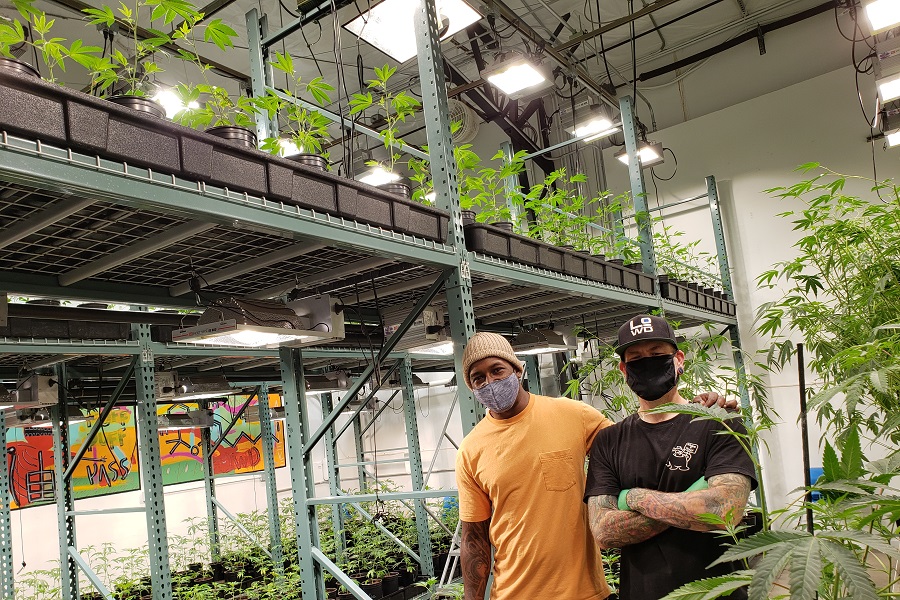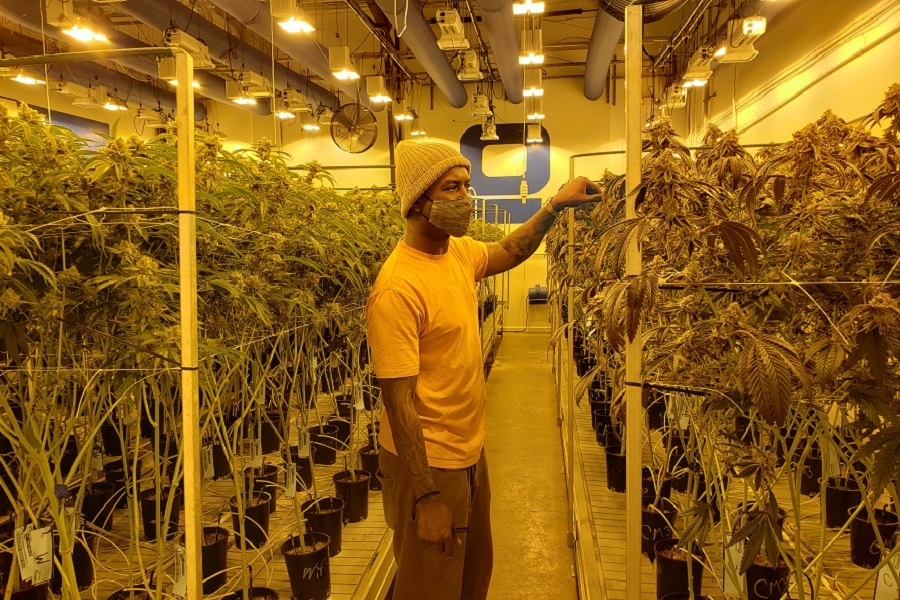A new wave of buyers has local growers and marijuana conglomerates competing for well-heeled customers.
Tall, wooden workbenches brought to mind Geppetto’s workshop or an architecture studio. Individual light fixtures, cutting mats and movable magnifying glasses gave the trimming room at LOWD cannabis cultivation facility in Portland an artisanal style. For founder and CEO Jesce Horton, trimming the bud is an artistic pursuit as well as an integral step in growing weed.
“Over here we’re a bunch of weed nerds,” says Horton, who left a career as an engineer in 2014 to pursue his passion for growing cannabis. He compared his operation to a small-batch beer company and refers to his product as “craft cannabis.” LOWD only makes enough product to sell to eight distributors across the state, but the consistency and quality of the flower has kept his high-end cannabis selling well, despite having a higher price point.
But a rush of new cannabis consumers and a swell of investment in large-label cannabis brands has meant more money coming into the sector, and more competition. As the cannabis market expands, both in customer base and competition, craft breeders increasingly rely on recognizable logos, regional reputation and vendors who can educate customers.
 Horton and LOWD cultivation manager Greg Billingsley beside LOWD’s vertical-growing installation. Credit: Sander Gusinow
Horton and LOWD cultivation manager Greg Billingsley beside LOWD’s vertical-growing installation. Credit: Sander Gusinow
President Joe Biden’s 2020 election victory caused a surge of investment in cannabis brands. Canada-based Canopy Growth’s stock increased 10% after Biden’s win and provoked excitement over the possibility of national legalization. The stock price of Aurora Cannabis, another Canadian company, grew 20%.
Despite regulations against cannabis products being sold across state lines, publicly traded companies have made inroads into Oregon’s $1 billion cannabis market.
“Big agribusiness may not be able to transport cannabis across state lines, but they can absolutely export flavors and methodologies,” says Jeremy Kwit, founder of Substance dispensary in Bend. “A lot of Oregonian suppliers got rolled up by non-Oregonian supply chains. The nationalization of cannabis has already begun.”
In 2019 Acreage Holdings, a subsidiary of Canopy Growth, licensed a growing operation in Medford, bringing its more affordable national strains to the market.
“The plan is to flood the market with cheap weed and roll up the competition once weed is legalized federally,” says a former budtender who chose to remain anonymous.
Anxiety over large conglomerates entering the cannabis market has been brewing for some time. In 2015 a widely spread rumor about Monsanto patenting its own cannabis strain was disproven on fact-checking website Snopes.
Oregon’s 625 square-foot canopy limit means large-scale outdoor operations are not as feasible as in other states. This could be the reason that Oregon’s cannabis industry has not seen as much consolidation as on the East Coast.
Multistory indoor operations, which maximize the number of plants that can be grown, has drawn indoor-cultivation manufacturers like Hawthorne Hydroponics, owned by gardening conglomerate ScottsMiracle-Gro, to set up shop.
RELATED STORY: Miracle Growth
Like a craft beer brand, LOWD has its seasonal and year-round strains as well as experimental varieties, which the company releases to test the market. For Horton, maintaining credibility with vendors and habitual users is the best strategy.
“We are so focused right now on these new consumers coming to join the market. And let’s be real: They are the bigger the piece of the market. But the regular and consistent users, we feel, are more valuable,” says Horton. “There’s going to be a rat race for people who can sell at the lowest prices and who can hire the best marketing team. As a craft producer you have to have a product that is satisfactory to the connoisseur market.”
According to a February report by the Oregon Liquor Control Commission, cannabis consumption increased 40% over the course of the pandemic. Approximately 20% of those users can be considered “connoisseurs” — buyers who are willing to spend the most money for the highest-quality product.
As cheaper cannabis enters the market, growers that can tap into clients willing to spend a lot of money are expected to have the most success.
“There has been a lot of talk in the region about a cannabis glut, but there’s actually a shortage of really high-end quality flower,” says Ryan Douglass, a New York-based cannabis consultant, who has a client setting up shop in Oregon.
COVID-19 has taken away the connoisseur’s most reliable way of sampling cannabis: smelling the jar. This means naming and branding are even more essential for attracting new business. In that respect, Oregon’s cannabis industry looks a lot more like the wine industry, says Douglass
“People who drink wine don’t know how the wine is going to taste before they buy it. The saying in the cannabis industry used to be: the nose knows. But it’s the name and label that are now the deciding factors,” says Douglass.
Advertising in the cannabis industry is also a challenge. Platforms like Google and Facebook have had record-breaking traffic this year, but neither site allows cannabis advertising. One vendor interviewed for this article says he tried to make a Facebook account for his company, only to find it shut down by moderators.
The inability to flood the web with advertising could be seen as an advantage for local growers. According to a 2020 market report by communication advisory firm ICR, more than half of cannabis consumers indicated a preference for local brands over national brands and small-batch producers over large-scale producers.
Cannabis consumers have historically been very sensitive to price when choosing products; but as the market expands, so do the price points. This makes it more difficult for new consumers, even ones willing to spend more for quality, to distinguish between mass-manufactured products and local craft cannabis.
“These people are newbies who are exploring cannabis for the first time, and all want to take it for different reasons. There is a learning and conversation that has to happen,” says Kwit. “You have to be a liquor store, a convenience store, a whole-foods and a wellness apothecary all in one.”
To subscribe to Oregon Business, click here.








